.


Administrative Region : Peloponnese
Regional unit : Lakonia
Sparta (Doric Σπάρτα; Attic Σπάρτη Spartē) or Lacedaemon, was a prominent city-state in ancient Greece, situated on the banks of the River Eurotas in Laconia, in south-eastern Peloponnese.[1] It emerged as a political entity around the 10th century BC, when the invading Dorians subjugated the local, non-Dorian population. From c. 650 BC it rose to become the dominant military land-power in ancient Greece.
Given its military pre-eminence, Sparta was recognized as the overall leader of the combined Greek forces during the Greco-Persian Wars.[2] Between 431 and 404 BC, Sparta was the principal enemy of Athens during the Peloponnesian War,[3] from which it emerged victorious, though at great cost. Sparta's defeat by Thebes in the Battle of Leuctra in 371 BC ended Sparta's prominent role in Greece. However, it maintained its political independence until the Roman conquest of Greece in 146 BC.
Sparta was unique in ancient Greece for its social system and constitution, which completely focused on military training and excellence. Its inhabitants were classified as Spartiates (Spartan citizens, who enjoyed full rights), Mothakes (non-Spartan free men raised as Spartans), Perioikoi (freedmen), and Helots (state-owned serfs, enslaved non-Spartan local population). Spartiates underwent the rigorous agoge training and education regimen, and Spartan phalanxes were widely considered to be among the best in battle. Spartan women enjoyed considerably more rights and equality to men than elsewhere in the classical world.
Sparta was the subject of fascination in its own day, as well as in the West following the revival of classical learning. Sparta continues to fascinate Western Culture; an admiration of Sparta is called laconophilia.
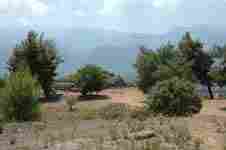
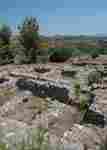
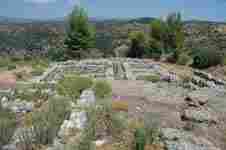
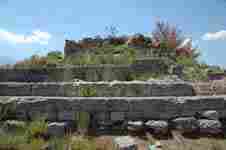
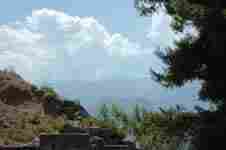
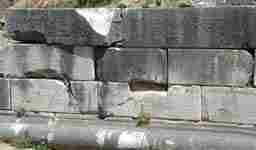
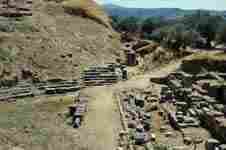
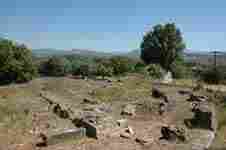
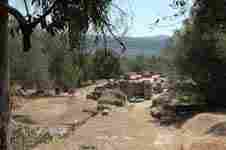
The earliest attested term referring to Lacedaemon is the Mycenaean Greek ra-ke-da-mi-ni-jo, "Lacedaimonian", written in Linear B syllabic script and transliterated as Λακεδαιμόνιος (Lakedaimonios) in the Greek alphabet.[4]
Eurotas River
The ancient Greeks used one of three words to refer to the home location of the Spartans. The first refers primarily to the main cluster of settlements in the valley of the Eurotas River: Sparta.[5] The second word was Lacedaemon (Λακεδαίμων);[6] this is the name commonly used in the works of Homer and the Athenian historians Herodotus and Thucydides. Herodotus seems to denote by it the Mycenaean Greek citadel at Therapne, in contrast to the lower town of Sparta. It could be used synonymously with Sparta, but typically it was not. It denoted the terrain on which Sparta was situated.[7] In Homer it is typically combined with epithets of the countryside: wide, lovely, shining and most often hollow and broken (full of ravines).[8] The hollow suggests the Eurotas Valley. Sparta on the other hand is the country of lovely women, a people epithet.
The name of the population was often used for the state of Lacedaemon: the Lacedaemonians. This epithet utilized the plural of the adjective, Lacedaemonius (Greek Λακεδαιμὀνιοι, Latin Lacedaemonii). If the ancients wished to refer to the country more directly, instead of Lacedaemon, they could use a back-formation from the adjective: Lacedaemonian country. As most words for "country" were feminine, the adjective was in the feminine: Lacedaemonia. Eventually, the adjective came to be used alone.
Lacedaemonia was not in general use during the classical period and before. It does occur in Greek as an equivalent of Laconia and Messenia during the Roman and early Byzantine periods, mostly in ethnographers and lexica glossing place names. For example, Hesychius of Alexandria's Lexicon (5th century AD) defines Agiadae as a "place in Lacedaemonia" named after Agis.[9] The actual transition may be captured by Isidore of Seville's Etymologiae (7th century AD), an etymological dictionary. He relied heavily on Orosius' Historiarum Adversum Paganos (5th century AD) and Eusebius of Caesarea's Chronicon (early 5th century AD) as did Orosius. The latter defines Sparta to be Lacedaemonia Civitas but Isidore defines Lacedaemonia as founded by Lacedaemon, son of Semele, relying on Eusebius.[10] There is a rare use, perhaps the earliest of Lacedaemonia, in Diodorus Siculus,[11] but probably with Χὠρα ("country") suppressed.
The immediate area around the town of Sparta, the plateau east of the Taygetos mountains, was generally referred as Laconice (Λακωνική).[12] This term was sometimes used to refer to all the regions under direct Spartan control, including Messenia.

252 : Statue of Pan found in Spart. Parian marble .
Lacedaemon is now the name of a province in the modern Greek prefecture of Laconia.
Geography
Sparta is located in the region of Laconia, in the south-eastern Peloponnese. Ancient Sparta was built on the banks of the Evrotas River, the main river of Laconia, which provided it with a source of fresh water. The valley of the Evrotas is a natural fortress, bounded to the west by Mt. Taygetus (2407 m) and to the east by Mt. Parnon (1935 m). To the north, Laconia is separated from Arcadia by hilly uplands reaching 1000 m in altitude. These natural defenses worked to Sparta's advantage and contributed to Sparta never having been sacked. Though landlocked, Sparta had a harbor, Gytheio, on the Laconian Gulf.
Mythology
In Greek mythology, Lacedaemon was a son of Zeus by the nymph Taygete. He married Sparta, the daughter of Eurotas, by whom he became the father of Amyclas, Eurydice, and Asine. He was king of the country which he named after himself, naming the capital after his wife. He was believed to have built the sanctuary of the Charites, which stood between Sparta and Amyclae, and to have given to those divinities the names of Cleta and Phaenna. A shrine was erected to him in the neighborhood of Therapne.
Archaeology of the classical period
The theater of ancient Sparta with Mt. Taygetus in the background.
Thucydides wrote:
Suppose the city of Sparta to be deserted, and nothing left but the temples and the ground-plan, distant ages would be very unwilling to believe that the power of the Lacedaemonians was at all equal to their fame. Their city is not built continuously, and has no splendid temples or other edifices; it rather resembles a group of villages, like the ancient towns of Hellas, and would therefore make a poor show.[13]
Until the early 20th century, the chief ancient buildings at Sparta were the theatre, of which, however, little showed above ground except portions of the retaining walls; the so-called Tomb of Leonidas, a quadrangular building, perhaps a temple, constructed of immense blocks of stone and containing two chambers; the foundation of an ancient bridge over the Eurotas; the ruins of a circular structure; some remains of late Roman fortifications; several brick buildings and mosaic pavements.
The remaining archaeological wealth consisted of inscriptions, sculptures, and other objects collected in the local museum, founded by Stamatakis in 1872 and enlarged in 1907. Partial excavation of the round building was undertaken in 1892 and 1893 by the American School at Athens. The structure has been since found to be semicircular, retaining wall of Hellenic origin that was partly restored during the Roman period.
Ruins from the ancient site
In 1904, the British School at Athens began a thorough exploration of Laconia, and in the following year excavations were made at Thalamae, Geronthrae, and Angelona near Monemvasia. In 1906, excavations began in Sparta.
A small circus described by Leake proved to be a theatre-like building constructed soon after AD 200 around the altar and in front of the temple of Artemis Orthia. Here musical and gymnastic contests took place as well as the famous flogging ordeal (diamastigosis). The temple, which can be dated to the 2nd century BC, rests on the foundation of an older temple of the 6th century, and close beside it were found the remains of a yet earlier temple, dating from the 9th or even the 10th century. The votive offerings in clay, amber, bronze, ivory and lead found in great profusion within the precinct range, dating from the 9th to the 4th centuries BC, supply invaluable evidence for early Spartan art.
In 1907, the sanctuary of Athena "of the Brazen House" (Chalkioikos) was located on the acropolis immediately above the theatre, and though the actual temple is almost completely destroyed, the site has produced the longest extant archaic inscription of Laconia, numerous bronze nails and plates, and a considerable number of votive offerings. The Greek city-wall, built in successive stages from the 4th to the 2nd century, was traced for a great part of its circuit, which measured 48 stades or nearly 10 km (Polyb. 1X. 21). The late Roman wall enclosing the acropolis, part of which probably dates from the years following the Gothic raid of AD 262, was also investigated. Besides the actual buildings discovered, a number of points were situated and mapped in a general study of Spartan topography, based upon the description of Pausanias. Excavations showed that the town of the Mycenaean Period was situated on the left bank of the Eurotas, a little to the south-east of Sparta. The settlement was roughly triangular in shape, with its apex pointed towards the north. Its area was approximately equal to that of the "newer" Sparta, but denudation has wreaked havoc with its buildings and nothing is left save ruined foundations and broken potsherds.
History
Main article: History of Sparta
Prehistory
The prehistory of Sparta is difficult to reconstruct because the literary evidence is far removed in time from the events it describes and is also distorted by oral tradition.[14] However, the earliest certain evidence of human settlement in the region of Sparta consists of pottery dating from the Middle Neolithic period, found in the vicinity of Kouphovouno some two kilometres south-southwest of Sparta.[15] These are the earliest traces of the original Mycenaean Spartan civilisation, as represented in Homer's Iliad.
This civilization seems to have fallen into decline by the late Bronze Age, when, according to Herodotus, Macedonian tribes from the north marched into Peloponnese, where they were called Dorians and subjugating the local tribes, settled there.[14] The Dorians seem to have set about expanding the frontiers of Spartan territory almost before they had established their own state.[16] They fought against the Argive Dorians to the east and southeast, and also the Arcadian Achaeans to the northwest. The evidence suggests that Sparta, relatively inaccessible because of the topography of the Taygetan plain, was secure from early on: it was never fortified.[16]
Lycurgus
Nothing distinctive in the archaeology of the Eurotas River Valley identifies the Dorians or the Dorian Spartan state. The prehistory of the Neolithic, the Bronze Age and the Dark Age (the Early Iron Age) at this moment must be treated apart from the stream of Dorian Spartan history.
The legendary period of Spartan history is believed to fall into the Dark Age. It treats the mythic heroes such as the Heraclids and the Perseids, offering a view of the occupation of the Peloponnesus that contains both fantastic and possibly historical elements. The subsequent proto-historic period, combining both legend and historical fragments, offers the first credible history.
Between the 8th and 7th centuries BC the Spartans experienced a period of lawlessness and civil strife, later testified by both Herodotus and Thucydides.[17] As a result they carried out a series of political and social reforms of their own society which they later attributed to a semi-mythical lawgiver, Lycurgus.[18] These reforms mark the beginning of the history of Classical Sparta.
Classical Sparta
In the Second Messenian War, Sparta established itself as a local power in Peloponnesus and the rest of Greece. During the following centuries, Sparta's reputation as a land-fighting force was unequaled.[19] In 480 BC a small force of Spartans, Thespians, and Thebans led by King Leonidas (approximately 300 were full Spartiates, 700 were Thespians, and 400 were Thebans although these numbers do not reflect casualties incurred prior to the final battle), made a legendary last stand at the Battle of Thermopylae against the massive Persian army, inflicting very high casualties on the Persian forces before finally being encircled.[20] The superior weaponry, strategy, and bronze armour of the Greek hoplites and their phalanx again proved their worth one year later when Sparta assembled at full strength and led a Greek alliance against the Persians at the battle of Plataea.
Statue of King Leonidas I at Sparta (1968)
The decisive Greek victory at Plataea put an end to the Greco-Persian War along with Persian ambition of expanding into Europe. Even though this war was won by a pan-Greek army, credit was given to Sparta, who besides being the protagonist at Thermopylae and Plataea, had been the de facto leader of the entire Greek expedition.[21]
In later Classical times, Sparta along with Athens, Thebes, and Persia had been the main powers fighting for supremacy against each other. As a result of the Peloponnesian War, Sparta, a traditionally continental culture, became a naval power. At the peak of its power Sparta subdued many of the key Greek states and even managed to overpower the elite Athenian navy. By the end of the 5th century BC it stood out as a state which had defeated the Athenian Empire and had invaded the Persian provinces in Anatolia, a period which marks the Spartan Hegemony.
During the Corinthian War Sparta faced a coalition of the leading Greek states: Thebes, Athens, Corinth, and Argos. The alliance was initially backed by Persia, whose lands in Anatolia had been invaded by Sparta and which feared further Spartan expansion into Asia.[22] Sparta achieved a series of land victories, but many of her ships were destroyed at the battle of Cnidus by a Greek-Phoenician mercenary fleet that Persia had provided to Athens. The event severely damaged Sparta's naval power but did not end its aspirations of invading further into Persia, until Conon the Athenian ravaged the Spartan coastline and provoked the old Spartan fear of a helot revolt.[23]
After a few more years of fighting, in 387 BC the Peace of Antalcidas was established, according to which all Greek cities of Ionia would return to Persian control, and Persia's Asian border would be free of the Spartan threat.[23] The effects of the war were to reaffirm Persia's ability to interfere successfully in Greek politics and to affirm Sparta's weakened hegemonic position in the Greek political system.[24] Sparta entered its long-term decline after a severe military defeat to Epaminondas of Thebes at the Battle of Leuctra. This was the first time that a Spartan army lost a land battle at full strength.
As Spartan citizenship was inherited by blood, Sparta now increasingly faced a helot population that vastly outnumbered its citizens. The alarming decline of Spartan citizens was commented on by Aristotle.
Hellenistic and Roman Sparta
Sparta never fully recovered from the losses that the Spartans suffered at Leuctra in 371 BC and the subsequent helot revolts. Nonetheless, it was able to continue as a regional power for over two centuries. Neither Philip II nor his son Alexander the Great attempted to conquer Sparta itself.
During Alexander's campaigns in the east, the Spartan king, Agis III sent a force to Crete in 333 BC with the aim of securing the island for Sparta.[25] Agis next took command of allied Greek forces against Macedon, gaining early successes, before laying siege to Megalopolis in 331 BC. A large Macedonian army under general Antipater marched to its relief and defeated the Spartan-led force in a pitched battle.[26] More than 5,300 of the Spartans and their allies were killed in battle, and 3,500 of Antipater's troops.[27] Agis, now wounded and unable to stand, ordered his men to leave him behind to face the advancing Macedonian army so that he could buy them time to retreat. On his knees, the Spartan king slew several enemy soldiers before being finally killed by a javelin.[28] Alexander was merciful, and he only forced the Spartans to join the League of Corinth, which they had previously refused to join.[29]
Even during its decline, Sparta never forgot its claims on being the "defender of Hellenism" and its Laconic wit. An anecdote has it that when Philip II sent a message to Sparta saying "If I enter Laconia, I will raze Sparta", the Spartans responded with the single, terse reply: "If."[30]
When Philip created the league of the Greeks on the pretext of unifying Greece against Persia, the Spartans chose not to join—they had no interest in joining a pan-Greek expedition if it was not under Spartan leadership. Thus, upon the conquest of Persia, Alexander the Great sent to Athens 300 suits of Persian armour with the following inscription "Alexander, son of Philip, and all the Greeks except the Spartans, give these offerings taken from the foreigners who live in Asia [emphasis added]".
During the Punic Wars Sparta was an ally of the Roman Republic. Spartan political independence was put to an end when it was eventually forced into the Achaean League. In 146 BC Greece was conquered by the Roman general Lucius Mummius. During the Roman conquest, Spartans continued their way of life, and the city became a tourist attraction for the Roman elite who came to observe exotic Spartan customs. Supposedly, following the disaster that befell the Roman imperial army at the Battle of Adrianople (AD 378), a Spartan militia phalanx met and defeated a force of raiding Visigoths in battle.[31]
Medieval and modern Sparta
According to Byzantine sources, some parts of the Laconian region remained pagan until well into the 10th century AD, and Doric-speaking populations survive today in Tsakonia. In the Middle Ages, the political and cultural center of Laconia shifted to the nearby settlement of Mystras. Modern Sparti was re-founded in 1834, by a decree of King Otto of Greece.
Structure of Classical Spartan society
Constitution
Main article: Spartan Constitution
The Doric state of Sparta, copying the Doric Cretans, developed a mixed governmental state. The state was ruled by two hereditary kings of the Agiad and Eurypontid families,[32] both supposedly descendants of Heracles and equal in authority, so that one could not act against the veto of his colleague.
The duties of the kings were primarily religious, judicial, and military. They were the chief priests of the state and also maintained communication with the Delphian sanctuary, which always exercised great authority in Spartan politics. In the time of Herodotus, about 450 BC, their judicial functions had been restricted to cases dealing with heiresses, adoptions and the public roads. Aristotle describes the kingship at Sparta as "a kind of unlimited and perpetual generalship" (Pol. iii. I285a),[33] while Isocrates refers to the Spartans as "subject to an oligarchy at home, to a kingship on campaign" (iii. 24).[34]
Civil and criminal cases were decided by a group of officials known as the ephors, as well as a council of elders known as the Gerousia. The Gerousia consisted of 28 elders over the age of 60, elected for life and usually part of the royal households, and the two kings.[35] High state policy decisions were discussed by this council who could then propose action alternatives to the Damos, the collective body of Spartan citizenry, who would select one of the alternatives by voting.[36][37]
The royal prerogatives were curtailed over time. Dating from the period of the Persian wars, the king lost the right to declare war and was accompanied in the field by two ephors. He was supplanted also by the ephors in the control of foreign policy. Over time, the kings became mere figureheads except in their capacity as generals. Real power was transferred to the ephors and to the Gerousia.
The origins of the powers exercised by the assembly of the citizens are virtually unknown because of the lack of historical documentation and Spartan state secrecy.
Citizenship
Not all inhabitants of the Spartan state were considered to be citizens. Only those who had undertaken the Spartan education process known as the agoge were eligible. However, usually the only people eligible to receive the agoge were Spartiates, or people who could trace their ancestry to the original inhabitants of the city.
There were two exceptions. Trophimoi or "foster sons" were foreign students invited to study. The Athenian general Xenophon, for example, sent his two sons to Sparta as trophimoi. The other exception was that the sons of a helot could be enrolled as a syntrophos if a Spartiate formally adopted him and paid his way. If a syntrophos did exceptionally well in training, he might be sponsored to become a Spartiate.[38]
Others in the state were the perioikoi, who were free inhabitants of Spartan territory but were non-citizens, and the helots,[39] the state-owned serfs. Descendants of non-Spartan citizens were not able to follow the agoge and Spartans who could not afford to pay the expenses of the agoge could lose their citizenship. These laws meant that Sparta could not readily replace citizens lost in battle or otherwise and eventually proved near fatal to the continuance of the state as the number of citizens became greatly outnumbered by the non-citizens and, even more dangerously, the helots.
Helots and Perioikoi
Helots
Main article: Helots
The Spartans were a minority of the Lakonian population. The largest class of inhabitants were the helots (in Classical Greek Εἵλωτες / Heílôtes).[40][41]
The helots were originally free Greeks from the areas of Messenia and Lakonia whom the Spartans had defeated in battle and subsequently enslaved. In other Greek city-states, free citizens were part-time soldiers who, when not at war, carried on other trades. Since Spartan men were full-time soldiers, they were not available to carry out manual labour.[42] The helots were used as unskilled serfs, tilling Spartan land. Helot women were often used as wet nurses. Helots also travelled with the Spartan army as non-combatant serfs. At the last stand of the Battle of Thermopylae, the Greek dead included not just the legendary three hundred Spartan soldiers but also several hundred Thespian and Theban troops and a number of helots.[43]
Relations between the helots and their Spartan masters were frequently hostile. Thucydides remarked that "Spartan policy is always mainly governed by the necessity of taking precautions against the helots."[44][45]
According to Myron of Priene[46] of the middle 3rd century BC:
"They assign to the Helots every shameful task leading to disgrace. For they ordained that each one of them must wear a dogskin cap (κυνῆ / kunễ) and wrap himself in skins (διφθέρα / diphthéra) and receive a stipulated number of beatings every year regardless of any wrongdoing, so that they would never forget they were slaves. Moreover, if any exceeded the vigour proper to a slave's condition, they made death the penalty; and they allotted a punishment to those controlling them if they failed to rebuke those who were growing fat".[47]
Plutarch also states that Spartans treated the Helots "harshly and cruelly": they compelled them to drink pure wine (which was considered dangerous – wine usually being cut with water) "...and to lead them in that condition into their public halls, that the children might see what a sight a drunken man is; they made them to dance low dances, and sing ridiculous songs..." during syssitia (obligatory banquets).[48]
Helots did not have voting rights, although compared to non-Greek chattel slaves in other parts of Greece they were relatively privileged. The Spartan poet Tyrtaios refers to Helots being allowed to marry.[49] They also seem to have been allowed to practice religious rites and, according to Thucydides, own a limited amount of personal property.[50]
Each year when the Ephors took office they ritually declared war on the helots, thereby allowing Spartans to kill them without the risk of ritual pollution.[51] This seems to have been done by kryptes (sing. κρύπτης), graduates of the Agoge who took part in the mysterious institution known as the Krypteia.[52]
Around 424 BC, the Spartans murdered two thousand helots in a carefully staged event. Thucydides states:
"The helots were invited by a proclamation to pick out those of their number who claimed to have most distinguished themselves against the enemy, in order that they might receive their freedom; the object being to test them, as it was thought that the first to claim their freedom would be the most high spirited and the most apt to rebel. As many as two thousand were selected accordingly, who crowned themselves and went round the temples, rejoicing in their new freedom. The Spartans, however, soon afterwards did away with them, and no one ever knew how each of them perished."[53][54]
Perioikoi
Main article: Perioeci
The Perioikoi came from similar origins as the helots but occupied a somewhat different position in Spartan society. Although they did not enjoy full citizen-rights, they were free and not subjected to the same harsh treatment as the helots. The exact nature of their subjection to the Spartans is not clear, but they seem to have served partly as a kind of military reserve, partly as skilled craftsmen and partly as agents of foreign trade.[55] Although Perioikoic hoplites occasionally served with the Spartan army, notably at the Battle of Plataea, the most important function of the Perioikoi was almost certainly the manufacture and repair of armour and weapons.[56]
Economy
Spartan citizens were debarred by law from trade or manufacture, which consequently rested in the hands of the Perioikoi, and were forbidden (in theory) to possess either gold or silver. Spartan currency consisted of iron bars,[57] thus making thievery and foreign commerce very difficult and discouraging the accumulation of riches.[58] Wealth was, in theory at least, derived entirely from landed property and consisted in the annual return made by the helots, who cultivated the plots of ground allotted to the Spartan citizens but this attempt to equalize property proved a failure. From the earliest times, there were marked differences of wealth within the state, and these became even more serious after the law of Epitadeus, passed at some time after the Peloponnesian War, removed the legal prohibition of the gift or bequest of land.[59]
Full citizens, released from any economic activity, were given a piece of land which was cultivated and run by the helots. As time went on, greater portions of land were concentrated in the hands of large landholders, but the number of full citizens declined. Citizens had numbered 10,000 at the beginning of the 5th century BC but had decreased by Aristotle's day (384–322 BC) to less than 1,000, and had further decreased to 700 at the accession of Agis IV in 244 BC. Attempts were made to remedy this situation by creating new laws. Certain penalties were imposed upon those who remained unmarried or who married too late in life. These laws, however, came too late and were ineffective in reversing the trend.
Life in Classical Sparta
Birth and death
Sparta was above all a militarist state, and emphasis on military fitness began virtually at birth. Shortly after birth, a mother would bathe her child in wine to see whether the child was strong. If the child survived it was brought before the Gerousia by the child's father. The Gerousia then decided whether it was to be reared or not. If they considered it "puny and deformed", the baby was thrown into a chasm on Mount Taygetos known euphemistically as the Apothetae (Gr., ἀποθέτας, "Deposits").[60][61] This was, in effect, a primitive form of eugenics.[60]
There is some evidence that the exposure of unwanted children was practiced in other Greek regions, including Athens.[62]
When Spartans died, marked headstones would only be granted to soldiers who died in combat during a victorious campaign or women who died either in service of a divine office or in childbirth.
Education
Main article: Agoge
When male Spartans began military training at age seven, they would enter the Agoge system. The Agoge was designed to encourage discipline and physical toughness and to emphasise the importance of the Spartan state. Boys lived in communal messes and were deliberately underfed, to encourage them to master the skill of stealing food. Besides physical and weapons training, boys studied reading, writing, music and dancing. Special punishments were imposed if boys failed to answer questions sufficiently 'laconically' (i.e. briefly and wittily).[63]
At the age of twelve, the Agoge obliged Spartan boys to take an older male mentor, usually an unmarried young man. The older man was expected to function as a kind of substitute father and role model to his junior partner; however, it is also reasonably certain that they had sexual relations (the exact nature of Spartan pederasty is not entirely clear).[64]
At the age of eighteen, Spartan boys became reserve members of the Spartan army. On leaving the Agoge they would be sorted into groups, whereupon some were sent into the countryside with only a knife and forced to survive on their skills and cunning. This was called the Krypteia, and the immediate object of it was to seek out and kill any helots as part of the larger program of terrorising and intimidating the helot population.[65]
Less information is available about the education of Spartan girls, but they seem to have gone through a fairly extensive formal educational cycle, broadly similar to that of the boys but with less emphasis on military training. In this respect, classical Sparta was unique in ancient Greece. In no other city-state did women receive any kind of formal education.[66]
Military life
Main articles: Spartan army and Spartiate
Marble statue of a helmed hoplite (5th century BC), Archæological Museum of Sparta, Greece
At age twenty, the Spartan citizen began his membership in one of the syssitia (dining messes or clubs), composed of about fifteen members each, of which every citizen was required to be a member. Here each group learned how to bond and rely on one another. The Spartan exercised the full rights and duties of a citizen at the age of thirty. Only native Spartans were considered full citizens and were obliged to undergo the training as prescribed by law, as well as participate in and contribute financially to one of the syssitia.[67]
Sparta, is thought to be the first city to practice athletic nudity, and one of the first to formalize pederasty.[68] The Spartans believed that the love of an older, accomplished aristocrat for an adolescent was essential to his formation as a free citizen. The agoge, the education of the ruling class, was thus founded on pederastic relationships required of each citizen.[69] The lover was responsible for the boy's training. Pederasty and military training were intimately connected in Sparta, as in many other cities. The Spartans, claims Athenaeus[70] sacrificed to Eros before every battle.
Spartan men remained in the active reserve until age sixty. Men were encouraged to marry at age twenty but could not live with their families until they left their active military service at age thirty. They called themselves "homoioi" (equals), pointing to their common lifestyle and the discipline of the phalanx, which demanded that no soldier be superior to his comrades.[71] Insofar as hoplite warfare could be perfected, the Spartans did so.[72]
Thucydides reports that when a Spartan man went to war, his wife (or another woman of some significance) would customarily present him with his shield and say: "With this, or upon this" (Ἢ τὰν ἢ ἐπὶ τᾶς, Èi tàn èi èpì tàs), meaning that true Spartans could only return to Sparta either victorious (with their shield in hand) or dead (carried upon it).[73] If a Spartan hoplite were to return to Sparta alive and without his shield, it was assumed that he threw his shield at the enemy in an effort to flee; an act punishable by death or banishment. A soldier losing his helmet, breastplate or greaves (leg armour) was not similarly punished, as these items were personal pieces of armour designed to protect one man, whereas the shield not only protected the individual soldier but in the tightly packed Spartan phalanx was also instrumental in protecting the soldier to his left from harm. Thus the shield was symbolic of the individual soldier's subordination to his unit, his integral part in its success, and his solemn responsibility to his comrades in arms — messmates and friends, often close blood relations.
According to Aristotle, the Spartan military culture was actually short-sighted and ineffective. He observed:
It is the standards of civilized men not of beasts that must be kept in mind, for it is good men not beasts who are capable of real courage. Those like the Spartans who concentrate on the one and ignore the other in their education turn men into machines and in devoting themselves to one single aspect of city's life, end up making them inferior even in that.[74]
Even mothers enforced the militaristic lifestyle that Spartan men endured. There is a legend of a Spartan warrior who ran away from battle back to his mother. Although he expected protection from his mother, she acted quite the opposite. Instead of shielding her son from public shame, she and some of her friends chased him around the streets, and beat him with sticks. Afterwards, he was forced to run up and down the hills of Sparta yelling his cowardliness and inferiority.[75][76]
Marriage
Spartan men were required to marry at age 30,[39] after completing the Krypteia.[77] Plutarch reports the peculiar customs associated with the Spartan wedding night:
The custom was to capture women for marriage(...) The so-called 'bridesmaid' took charge of the captured girl. She first shaved her head to the scalp, then dressed her in a man's cloak and sandals, and laid her down alone on a mattress in the dark. The bridegroom—who was not drunk and thus not impotent, but was sober as always—first had dinner in the messes, then would slip in, undo her belt, lift her and carry her to the bed.[78]
The husband continued to visit his wife in secret for some time after the marriage. These customs, unique to the Spartans, have been interpreted in various ways. The "abduction" may have served to ward off the evil eye, and the cutting of the wife's hair was perhaps part of a rite of passage that signalled her entrance into a new life.[79]
Role of women
Main article: Women in ancient Sparta
Political, social, and economic equality
Spartan women enjoyed a status, power, and respect that was unknown in the rest of the classical world. They controlled their own properties, as well as the properties of male relatives who were away with the army. It is estimated that women were the sole owners of at least 35% of all land and property in Sparta.[80] The laws regarding a divorce were the same for both men and women. Unlike women in Athens, if a Spartan woman became the heiress of her father because she had no living brothers to inherit (an epikleros), the woman was not required to divorce her current spouse in order to marry her nearest paternal relative.[81] Spartan women rarely married before the age of 20, and unlike Athenian women who wore heavy, concealing clothes and were rarely seen outside the house, Spartan women wore short dresses and went where they pleased. Girls as well as boys exercised nude, and young women as well as young men may have participated in the Gymnopaedia ("Festival of Nude Youths").[82][83]
Historic women
Many women played a significant role in the history of Sparta.[84] Queen Gorgo, heiress to the throne and the wife of Leonidas I, was an influential and well-documented figure. Herodotus records that as a small girl she advised her father Cleomenes to resist a bribe. She was later said to be responsible for decoding a warning that the Persian forces were about to invade Greece; after Spartan generals could not decode a wooden tablet covered in wax, she ordered them to clear the wax, revealing the warning.[85] Plutarch's Moralia contains a collection of "Sayings of Spartan Women", including a laconic quip attributed to Gorgo: when asked by a woman from Attica why Spartan women were the only women in the world who could rule men, she replied "Because we are the only women who are mothers of men".[86]
Laconophilia
Main article: Laconophilia
Laconophilia is love or admiration of Sparta and of the Spartan culture or constitution. Sparta was subject of considerable admiration in its day, even in its rival, Athens. In ancient times "Many of the noblest and best of the Athenians always considered the Spartan state nearly as an ideal theory realised in practice."[87] Many Greek philosophers, especially Platonists, would often describe Sparta as an ideal state, strong, brave, and free from the corruptions of commerce and money.
Young Spartans Exercising by Edgar Degas (1834-1917)
With the revival of classical learning in Renaissance Europe, Laconophilia re-appears, for examples in the writings of Machiavelli. The Elizabethan English constitutionalist John Aylmer compared the mixed government of Tudor England to the Spartan republic, stating that "Lacedemonia [meaning Sparta], [was] the noblest and best city governed that ever was". He commended it as a model for England. The Swiss-French philosopher Jean-Jacques Rousseau contrasted Sparta favourably with Athens in his Discourse on the Arts and Sciences, arguing that its austere constitution was preferable to the more cultured nature of Athenian life. Sparta was also used as a model of social purity by Revolutionary and Napoleonic France.[88]
A new element of Laconophilia by Karl Otfried Müller, who linked Spartan ideals to the supposed racial superiority of the Dorians, the ethnic sub-group of the Greeks to which the Spartans belonged. Adolf Hitler praised the Spartans, recommending in 1928 that Germany should imitate them by limiting "the number allowed to live". He added that "The Spartans were once capable of such a wise measure... The subjugation of 350,000 Helots by 6,000 Spartans was only possible because of the racial superiority of the Spartans." The Spartans had created "the first racialist state".[89]
In the modern times, the adjective "spartan" is used to imply simplicity, frugality, or avoidance of luxury and comfort.[90] The term laconic phrase describes a very terse and concise way of speaking that was characteristic of the Spartans.
Sparta also features prominently in modern popular culture (see Sparta in popular culture), particularly the Battle of Thermopylae (see Battle of Thermopylae in popular culture).
Famous ancient Spartans
Agis I – king
Agis II – king
Agesilaus II – king
Cleomenes I – king
Leonidas I (c. 520-480 BC) – king, famous for his actions at the Battle of Thermopylae
Cleomenes III – king and reformer
Lysander (5th–4th century BC) – general
Lycurgus (10th century BC) – lawgiver
Chionis (7th century BC) – athlete
Cynisca (4th century BC) – princess and athlete
Chilon – philosopher
Gorgo – queen and politician
Helen – of the Trojan War, Queen of Sparta
Menelaus – King of Sparta during the Trojan War
See also
List of Kings of Sparta
| Municipal Community Spartiates |
|---|
| Agia Kyriaki (Αγία Κυριακή, η) |
| Gounaris (Γούναρης, ο) |
| Kalami (Καλάμι, το) |
| Kokkinorrachi (Κοκκινόρραχη, η) |
| Riviotissa (Ριβιώτισσα, η) |
| Sparta (Σπάρτη, η) |
Notes
^ Cartledge 2002, p. 91
^ Cartledge 2002, p. 174
^ Cartledge 2002, p. 192
^ Palaeolexicon, Word study tool of ancient languages
^ LIddell & Scott 1940, Σπάρτη
^ Liddell & Scott 1940, Λακεδαίμων
^ MacBean, Alexander; Johnson, Samuel (1773). "Lacedaemon". A Dictionary of Ancient Geography [etc.]. London: G. Robinson [etc.]..
^ Autenrieth 1891, Λακεδαίμων
^ Schmidt, Maurice, ed (1863). "Άγιαδαι". Hesychii Alexandrini Lexicon. Jena: Frederick Mauk..
^ Wiener, Leo (1920). Contributions toward a History of Arabic-Gothic Culture. V. III: Tacitus' Germania & Other Forgeries. Philadelphia: Innes & Sones. p. 20..
^ Library, 19.70.2.
^ Cartledge 2002, p. 4
^ Thucydides, i. 10
^ a b Herodot, Book I, 56.3
^ Cartledge 2002, p. 28
^ a b Ehrenberg 2004, p. 31
^ Ehrenberg 2004, p. 36
^ Ehrenberg 2004, p. 33
^ "A Historical Commentary on Thucydides"—David Cartwright, p. 176
^ Green 1998, p. 10
^ Britannica ed. 2006, "Sparta"
^ "Dictionary of Ancient&Medieval Warfare"—Matthew Bennett, p. 86
^ a b "The Oxford Illustrated History of Greece and the Hellenistic World" p. 141, John Boardman, Jasper Griffin, Oswyn Murray
^ Fine, The Ancient Greeks, 556-9
^ Agis III
^ Agis III, by E. Badian © 1967 - Jstor
^ Diodorus, World History
^ Diodorus, World History, 17.62.1-63.4;tr. C.B. Welles
^ Alexander the Great and his time By Agnes Savill Page 44 ISBN 0-88029-591-0
^ Europe: a History—Norman Davies
^ The Military Engineer, By Society of American Military Engineers
^ Cartledge 2002, p. 89
^ The Encyclopædia Britannica: A Dictionary of Arts, Sciences, Literature and ... - Page 611. primary and secondary source
^ The Encyclopædia Britannica: A Dictionary of Arts, Sciences, Literature and ... - Page 611. primary secondary source
^ The Greeks at War By Philip De Souza, Waldemar Heckel, Lloyd Llewellyn-Jones, Victor Davis Hanson
^ The Politics By Aristotle, Thomas Alan Sinclair, Trevor J. Saunders
^ A companion to Greek studies By Leonard Whibley
^ The Greek World By Anton Powell
^ a b Ancient Greece By Sarah B. Pomeroy, Stanley M. Burstein, Walter Donlan, Jennifer Tolbert Roberts
^ Herodotus (IX, 28–29)
^ Xenophon, Hellenica, III, 3, 5
^ Cartledge 2002, p. 140
^ Ehrenberg 2004, p. 159
^ Thucydides (4, 80); the Greek is ambiguous
^ Cartledge 2002, p. 211
^ Talbert, p.26.
^ Apud Athenaeus, 14, 647d = FGH 106 F 2. Trans. by Cartledge, p.305.
^ Life of Lycurgus 28, 8-10. See also, Life of Demetrios, 1, 5; Constitution of the Lacedemonians 30; De Cohibenda Ira 6; De Commmunibus Notitiis 19.
^ West 1999, p. 24
^ Cartledge 2002, p. 141
^ (Plutarch, Life of Lycurgus 28, 7)
^ Powell 2001, p. 254
^ Thucydides (Book IV 80.4).
^ Classical historian Anton Powell has recorded a similar story from 1980s El Salvador. Cf. Powell, 2001, p. 256
^ Cartledge 2002, pp. 153–155
^ Cartledge 2002, p. 158,178
^ Excel HSC Ancient History By Peter Roberts, ISBN 1741251788, 9781741251784
^ Greene, Robert (2000), The 48 Laws of Power, Penguin Books, p. 420, ISBN 0140280197
^ Social Conflict in Ancient Greece By Alexander Fuks, ISBN 9652234664, 9789652234667
^ a b Cartledge 2001, p. 84
^ Plutarch 2005, p. 20
^ Buxton 2001, p. 201
^ Cartledge 2001, p. 85
^ Cartledge 2001, pp. 91–105
^ Cartledge 2001, p. 88
^ Cartledge 2001, pp. 83–84
^ Aristophanes and Athenian Society of the Early Fourth Century B.C. By E. David
^ Thomas F. Scanlon, "The Dispersion of Pederasty and the Athletic Revolution in Sixth-Century BC Greece," in Same-Sex Desire and Love in Greco-Roman Antiquity and in the Classical Tradition of the West, pp. 64-70.
^ Erich Bethe,Die Dorische Knabenliebe: ihre Ethik und ihre Ideen, 1907, 441, 444
^ Athenaeus of Naucratis, The Deipnosophists, XIII: Concerning Women
^ Readers Companion Military Hist p. 438—Cowley
^ Adcock 1957, pp. 8–9
^ Plutarch 2004, p. 465
^ Forrest 1968, p. 53
^ Spartan Women By Sarah B. Pomeroy
^ The Greeks By H. D. F. Kitto, ISBN 020230910X, 9780202309101
^ A Brief History of Citizenship By Derek Benjamin Heater, Derek Heater
^ Plutarch 2005, pp. 18–19
^ Pomeroy 2002, p. 42
^ Pomeroy, 1975
^ Pomeroy, Sarah B. Goddess, Whores, Wives, and Slaves: Women in Classical Antiquity. New York: Schocken Books, 1995 p. 60-62
^ Guttentag and Secord, 1983; Finley, 1982; Pomeroy, 1975
^ Pomeroy 2002, p. 34
^ "Gorgo and Spartan Women". Web.archive.org. 2009-10-27. Archived from the original on 2009-10-27. Retrieved 2011-08-10.
^ Helena Schrader (2010-07-11). "Sparta Reconsidered—Spartan Women". Elysiumgates.com. Retrieved 2011-08-10.
^ Plutarch 2004, p. 457
^ Mueller:Dorians II, 192
^ Žižek, Slavoj. "The True Hollywood Left". www.lacan.com.
^ "Professor Ben Kiernan, ''Hitler, Pol Pot, and Hutu Power: Distinguishing Themes of Genocidal Ideology'', Holocaust and the United Nations Discussion Paper". Un.org. Retrieved 2011-08-10.
^ Webster Dictionary http://www.merriam-webster.com/dictionary/Spartan%5B2%5Dhttp://www.merriam-webster.com/dictionary/Spartan
References
Adcock, F.E. (1957), The Greek and Macedonian Art of War, Berkeley: University of California Press, ISBN 0520000056
Autenrieth, Georg (1891). A Homeric Dictionary for Schools and Colleges. New York: Harper and Brothers.
Bradford, Ernle (2004), Thermopylae: The Battle for the West, New York: Da Capo Press, ISBN 0306813602
Buxton, Richard (1999), From Myth to Reason?: Studies in the Development of Greek Thought, Oxford: Clarendon Press, ISBN 0753451107
Cartledge, Paul (2002), Sparta and Lakonia: A Regional History 1300 to 362 BC (2 ed.), Oxford: Routledge, ISBN 0415262763
Cartledge, Paul (2001), Spartan Reflections, London: Duckworth, ISBN 0715629662
Cartledge, Paul. "What have the Spartans Done for us?: Sparta's Contribution to Western Civilization", Greece & Rome, Vol. 51, Issue 2 (2004), pp. 164–179.
Cartledge, Paul; Spawforth, Antony (2001), Hellenistic and Roman Sparta (2 ed.), Oxford: Routledge, ISBN 0415262771
Ehrenberg, Victor (1973), From Solon to Socrates: Greek History and Civilisation between the 6th and 5th centuries BC (2 ed.), London: Routledge, ISBN 0415040248
Forrest, W.G. (1968), A History of Sparta, 950–192 B.C., New York: W. W. Norton & Co.
Green, Peter (1998), The Greco-Persian Wars (2 ed.), Berkeley: University of California Press, ISBN 0520203135
Liddell, Henry George; Scott, Robert (1940). Jones, Henry Stuart. ed. A Greek-English Lexicon. Oxford: Clarendon Press..
Morris, Ian (1992), Death-Ritual and Social Structure in Classical Antiquity, Cambridge: Cambridge University Press, ISBN 0521376114
Pomeroy, Sarah B. (2002), Spartan Women, Oxford: Oxford University Press, ISBN 9780195130676
Powell, Anton (2001), Athens and Sparta: Constructing Greek Political and Social History from 478 BC (2 ed.), London: Routledge, ISBN 0415262801
Plutarch (2005), Richard J.A. Talbert, ed., On Sparta (2 ed.), London: Penguin Books, ISBN 0140449434
Plutarch (2004), Frank Cole Babbitt, ed., Moralia Vol. III, Loeb Classical Library, Cambridge: Harvard University Press, ISBN 0674992709
Thompson, F. Hugh (2002), The Archaeology of Greek and Roman Slavery, London: Duckworth, ISBN 0715631950
Thucydides (1974), M.I. Finley, Rex Warner, ed., History of the Peloponnesian War, London: Penguin Books, ISBN 0140440399
West, M.L. (1999), Greek Lyric Poetry, Oxford: Oxford University Press, ISBN 9780199540396
This article incorporates text from a publication now in the public domain: Chisholm, Hugh, ed (1911). Encyclopædia Britannica (11th ed.). Cambridge University Press.
Greece :
A - B - C - D - E - F - G - H - I - J - K - L - M -
N - O - P - Q - R - S - T - U - V - W - X - Y - Z
| Ancient Greece
Science, Technology , Medicine , Warfare, , Biographies , Life , Cities/Places/Maps , Arts , Literature , Philosophy ,Olympics, Mythology , History , Images Medieval Greece / Byzantine Empire Science, Technology, Arts, , Warfare , Literature, Biographies, Icons, History Modern Greece Cities, Islands, Regions, Fauna/Flora ,Biographies , History , Warfare, Science/Technology, Literature, Music , Arts , Film/Actors , Sport , Fashion --- |
Retrieved from "http://en.wikipedia.org/"
All text is available under the terms of the GNU Free Documentation License


